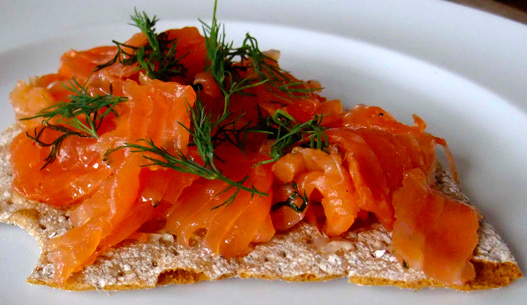Signe Johansen grew up in Norway spending time learning to cook with her farmor (grandmother). She enjoyed learning about everything from cured fish dishes, such as gravadlax, to the many traditional cakes and biscuits. In her first book Scandilicious: Secrets of Scandinavian Cooking she shares her passion for Scandinavian food showing us how simple and delicious it is.
The recipe I’ve shared with you here is from my book Scandilicious: Secrets of Scandinavian Cooking and it’s super-duper easy to make. Works a treat for lazy brunches on the weekend, just spread on sourdough crispbread, or keep in the freezer for midweek suppers. It’s perfect if you are entertaining a large group of people and of course it tastes delicious too.
Signe Johansen’s Gravadlax with dill mustard sauce*
* I actually prefer this naked, or with a little freshly grated horseradish on top and some pickled beetroot
The key to this classic Scandinavian dish is an exceptionally fresh fillet of salmon. If in doubt, freeze the fillet for 24 hours to kill any bacteria, then defrost it. This traditional gravlaks cure is slightly more sweet than salty, but you can always use equal quantities of sugar and salt if you prefer. If you’re feeling adventurous, try adding beetroot, alcohol (aquavit, gin or vodka) or juniper berries to the cure.
Makes enough for 12-14 starters or 6-8 smörgåsbord brunches
- 1½kg salmon fillet, cut in half
- 1 tbsp white peppercorns
- 2 tbsp coriander seeds
- 100g granulated sugar
- 75g sea salt
- 3 x 15g pack dill, chopped (for the cure)
- 1 x 15g pack dill, chopped (to serve)
Dill mustard sauce:
- 1 x 15g pack dill
- 3 tbsp vegetable oil
- 3 tbsp white wine or cider vinegar
- 3 tbsp demerara sugar
- 3 tbsp mustard
- ½ tsp salt
Method:
- Dry the salmon, check for pinbones and then place both fillet pieces side by side, skin down. Crush the white pepper and coriander with a pestle and mortar and then mix in a small bowl with the sugar and salt. Spread the dill over the skinless side of the fillet halves, then spread the spiced sugar and salt in a layer on top. Sandwich both fillets together so that the the dill spice mixture is in the middle and the skin is outermost. Cover any exposed surface of salmon with any dill and spice mixture that tumbles out. Wrap very tightly in two layers of clingfilm and place in a small roasting tin to catch the brine that escapes the fish as it cures. Refrigerate for a minimum of 24 hours and up to 48 hours.
2. The dill mustard sauce is very easy to make. Whizz up all the ingredients in a blender. You can then either use it straight away or keep it in an airtight glass jar in the fridge for a week or so.
3. When the gravlaks has had time to cure, simply take it out of the fridge, remove the clingfilm, wipe the fillet halves clean of the herby spiced salt with a paper towel, pat dry and put on a board, skin down. Put a layer of chopped dill on the skinless side of each fillet and press down as much as you can without squashing the fish. Slice on the diagonal from the tail towards the middle of the fillet and serve with hot new potatoes, rye or sourdough crispbread and dill mustard sauce.
Images of finished dish copyright Signe Johansen
